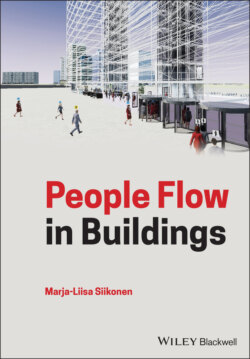Читать книгу People Flow in Buildings - Marja-Liisa Siikonen - Страница 23
2.1 Counting Technology Inside and Outside Buildings
ОглавлениеVertical passenger traffic can be measured manually, with access control systems, with elevator monitoring systems, with Automatic Passenger Counting (APC), with mobile devices, or with external counting devices. Passenger‐counting data is often provided by agencies or consultants to support building property management, but also transportation device suppliers offer this type of data. Passenger traffic measured from elevators, escalators and stairs gives a comprehensive picture of the vertical traffic and occupation in a building. Hall calls given by passengers in the lobby or car calls given inside the car correlate with the number of passenger trips. This information cannot be directly used in passenger counting since all passengers do not need to give a call. With additional logic of elevator trip data, passenger origin and destination floors can be deduced, and the number of people can be estimated quite accurately (Kuusinen 2015 ). With destination control every passenger are supposed give a call, and can thus provide more accurate information of passenger arrivals, vertical movement and waiting and journey times in elevators. The information is accurate if all passengers give the calls which is not always the case. Floor‐based service‐level data gives information about floor utilization and passenger waiting times for each floor.
Passenger‐counting technologies and procedures of public transportation vehicles have been widely researched. According to the studies, still at the turn of the last millennium, manual counting with paper and pen was the most popular method in traffic studies. Agencies following their own data collection procedures regardless of the counting technology are specialized in the field. Many agencies rely on combined manual counting and electronic fare collection. Modern ways to count passengers in buses and mass transits is to use electronic registering fareboxes (ERF) or smart card technology. When the APC technology is used, the number of employees assigned to passenger counting can be decreased to less than half (Boyle 1998 ). In trains, metros and buses, typically the ridership data, numbers of boarding and alighting persons by stop, and vehicle loading are measured. The ridership per trip or route and per time periods are used to access changes in ridership, to add and to delete vehicle trips, revise routes, and to calculate and adjust performance measures. The ridership can also roughly be estimated from the passenger revenue. The organizational units use system‐level data, e.g. budget and finance, and segment level analysis. They make high‐level decisions, such as scheduling to adjust running times and the planning of the location of bus shelters.
Vehicle traffic and people flow segmentation into user groups helps to understand the transportation needs. Outside buildings, global positioning system (GPS) connection can be used, and inside buildings, passenger journeys can be traced with modern mobile phones and wireless network protocols (Wi‐Fi) connection, or with APC and electronic devices. User group data helps in defining typical passenger routes and their agenda during the day. Heat maps show the crowded areas on maps or on the building floors. In the planning stage, transport devices can be placed on the most crowded user routes to serve efficiently all user groups and to avoid bottlenecks in traffic. In the following the methods that can be used in people counting mainly inside buildings are briefly described.
